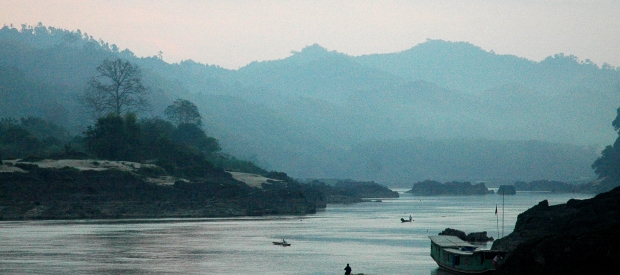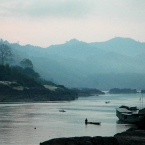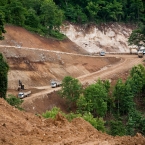Xayaburi Dam
As the Mekong River flows through the mountainous province of Xayaboury in northern Laos, it becomes the spawning grounds of migratory fish species that feed millions of people along the entire length of the river. Along the riverbanks, villagers grow fruits and vegetables and pan for gold. In Cambodia, Laos, Thailand, and Vietnam, the Mekong River provides food security, livelihoods, and cultural identity.
However, this way of life is now threatened. In 2010, the Lao and Thai governments began building the massive 1,285 megawatt Xayaburi Dam on the Mekong River. The project is being built by Ch. Karnchang, one of Thailand’s largest construction companies. It is being financed by six Thai commercial banks, including Siam Commercial Bank, Kasikorn Bank, Bangkok Bank, Krung Thai Bank, TISCO, and the Export-Import Bank of Thailand (EXIM). Thailand’s electricity utility, EGAT, has agreed to purchase 95% of the dam’s electricity. Energy experts in Thailand have concluded that Thailand does not need the dam’s electricity to meet its growing energy demand. However, the dam is expected to bring enormous profits to these companies and the Lao government.
The costs of the Xayaburi Dam will be borne by the millions of people who live along the Mekong River, including in Laos and Thailand. Scientists expect that the dam will block critical fish migration routes for between 23 to 100 species, including the iconic Mekong Giant Catfish. The dam would also destroy the river’s complex ecosystems that serve as important fish habitats. It would block the flow of sediments and nutrients, affecting agriculture as far downstream as the Mekong Delta in Vietnam. The Lao government will resettle at least 2,100 people, and 202,000 people living near the dam site will be directly affected. Even in the early stages of construction, many of these people already face threats to their food security.
The Xayaburi Dam also sets a dangerous precedent for dam-building along the Mekong River. Eleven dams are proposed for the Lower Mekong River, nine of them in Laos. According to a Strategic Environmental Assessment published by the Mekong River Commission in 2010, these dams would together affect millions of people living across the river basin.
Neighboring governments are concerned. According to a 1995 treaty, the four governments of Cambodia, Laos, Thailand, and Vietnam are required to seek agreement before building any of the Mekong dams. The process is called “prior consultation” and facilitated by the Mekong River Commission. However, such agreement was never sought for the Xayaburi Dam. Despite requests from Cambodia and Vietnam, Laos and Thailand even refused to study the dam’s transboundary impacts before beginning construction. The project’s current environmental impact assessment only examines impacts 10 kilometers downstream from the dam site. Laos’ engineer for the project, the Pöyry company of Finland, also claims that it can rely on unproven technologies to mitigate any harm the dam might cause. The full extent of the dam’s impacts remains unknown.
Construction activities began in late 2010, but Laos called these activities “preliminary work” for several years and even claimed at times that construction was delayed. On 7 November, 2012, Laos and Thailand held an official groundbreaking ceremony after claiming that Cambodia and Vietnam now support the project. At the MRC's Council meeting in January 2013, Cambodia, Vietnam, and the MRC’s donor governments all continued to raise concerns about the project. Construction on the project is proceeding rapidly and much of the river has already been blocked off.
Together with our partners the Thai People’s Network for the Mekong and the Save the Mekong Coalition, International Rivers is calling on regional governments to seek better energy solutions to protect the Mekong River, which is a lifeline for millions in the region.
- Please visit our Media Kit and Research Guide for more information on the Xayaburi Dam.
- An Interactive History of the Xayaburi Dam - Timeline
- Factsheet on the Xayaburi Dam (in English, Khmer, Lao, Thai, and Vietnamese).
- Factsheet on the Lower Mekong Dams (in English, Khmer, Lao, Thai, and Vietnamese).
- Xayaburi Dam Photo galleries
- Visit the Save the Mekong coalition website







